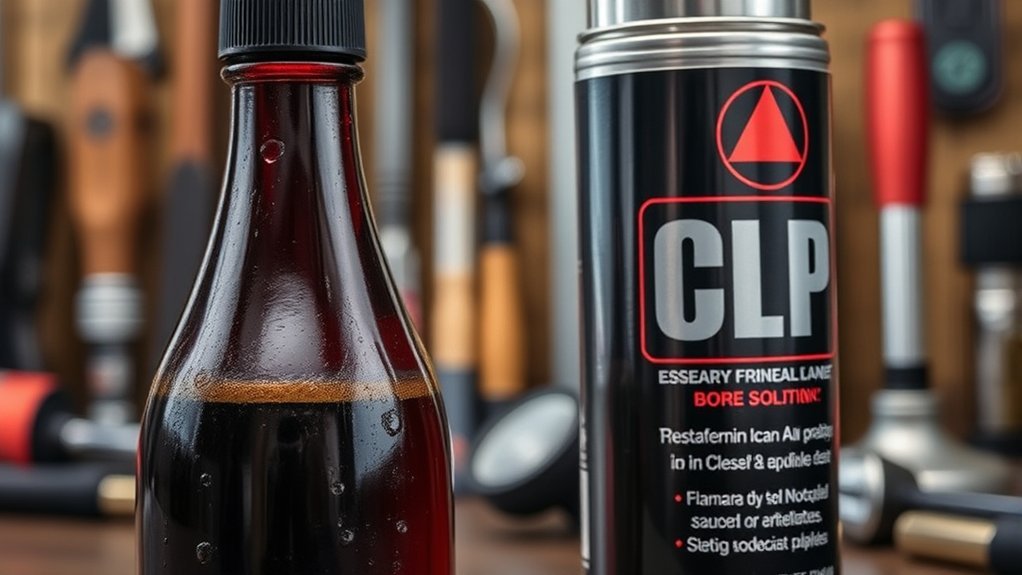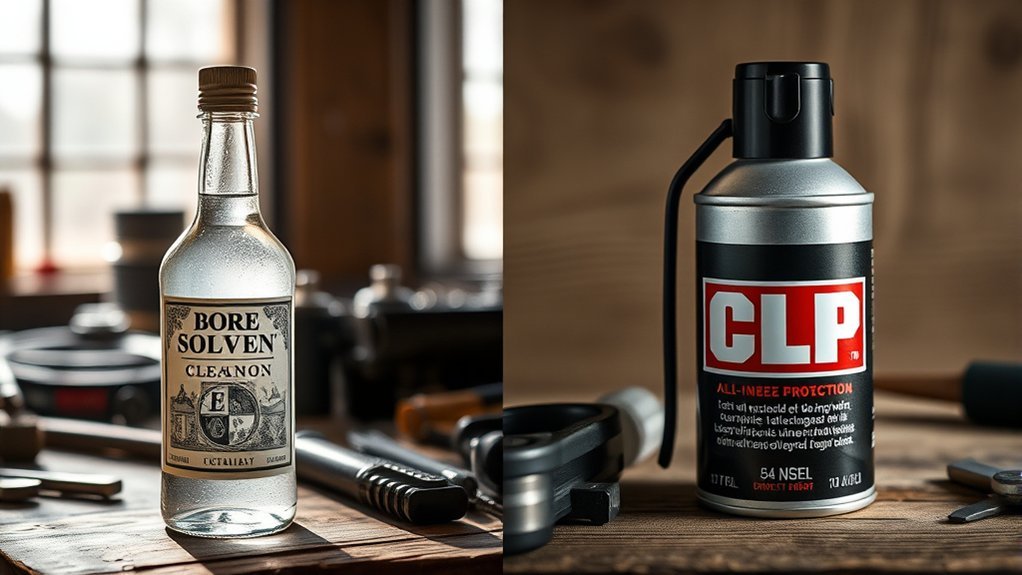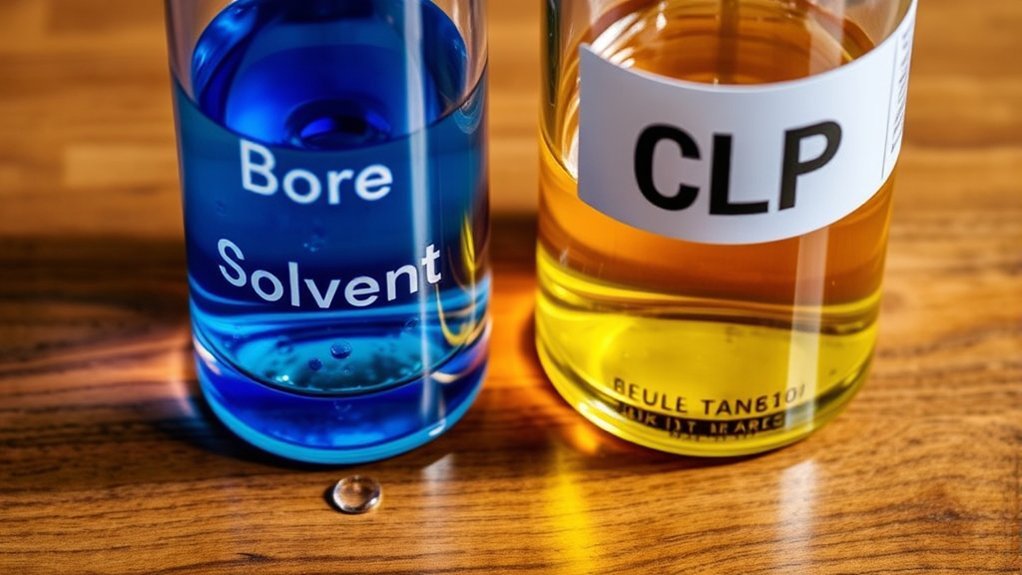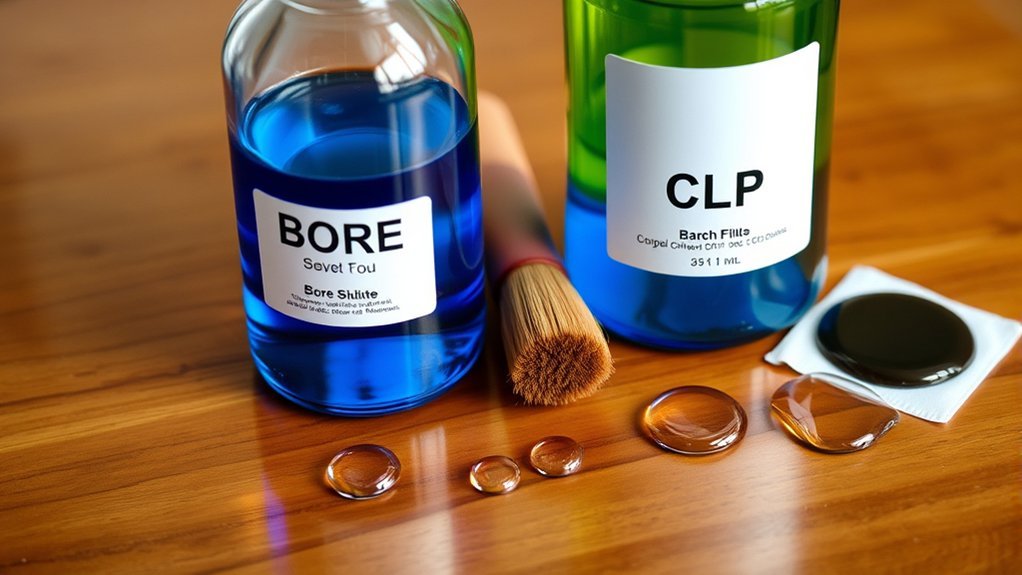When it comes to firearm maintenance, choosing the right product can feel like maneuvering through a maze. Bore solvents and CLP each have their unique strengths, catering to different cleaning and protection needs. Understanding these key differences is essential. While one excels in deep cleaning, the other offers a more thorough maintenance approach. So, which one should you reach for in your next cleaning session? Let’s break down the specifics.
Understanding Bore Solvent

Bore solvent is a specialized cleaning agent designed to remove fouling and residue from the interior of firearm barrels. This solvent effectively breaks down carbon, copper, and lead deposits, ensuring peak barrel performance. When using bore solvent, you should apply it liberally to a cleaning patch or brush and push it through the barrel, allowing it to penetrate for a few minutes. This dwell time helps the solvent dissolve stubborn fouling. Afterward, you’ll want to run dry patches through the barrel until they emerge clean. Regular use of bore solvent can enhance accuracy and prolong the life of your firearm. Always follow the manufacturer’s instructions for safe handling and proper application to avoid damage to your firearm’s components.
The Role of CLP

When you consider the role of CLP, it’s crucial to understand its multifunctional nature as a cleaning agent, lubricant, and corrosion protector. It effectively removes fouling and debris while providing a protective film to reduce wear and tear. Additionally, CLP helps combat rust and corrosion, ensuring your equipment remains in prime condition.
Cleaning Agents Overview
Cleaning agents play an essential role in maintaining the performance and longevity of firearms, and CLP (Cleaner, Lubricant, Protectant) is a popular choice among gun owners. CLP effectively removes dirt, carbon buildup, and fouling while providing a protective barrier against corrosion. Its formulation allows for quick application, simplifying the cleaning process. CLP’s versatility makes it suitable for various firearm types, ensuring that you can use it across your collection. Additionally, it penetrates tight spaces, reaching areas that might be missed with traditional cleaners. While it excels in cleaning, its protective and lubricating properties also contribute to the overall maintenance of your firearm. By incorporating CLP into your routine, you enhance your firearm’s reliability and lifespan.
Lubrication Properties Explained
While many gun owners focus on cleaning, understanding the lubrication properties of CLP is equally essential for peak firearm performance. CLP, which stands for Cleaner, Lubricant, and Protector, serves a dual purpose. Its lubricant component minimizes friction between moving parts, reducing wear and tear, and promoting smoother operation. When applied correctly, CLP creates a thin film that adheres to metal surfaces, ensuring optimal performance during firing cycles. This film also helps to maintain tolerances, allowing your firearm to operate efficiently. Unlike some dedicated lubricants, CLP combines cleaning and lubrication, streamlining your maintenance routine. Regular application of CLP not only enhances your firearm’s performance but also contributes to its longevity, making it a valuable addition to your cleaning regimen.
Protection Against Corrosion
CLP not only enhances lubrication but also plays a significant role in protecting your firearm against corrosion. Its formulation includes rust-inhibiting additives that form a protective barrier on metal surfaces. This barrier prevents moisture and environmental contaminants from causing oxidation and rust, which can compromise your firearm’s performance and longevity. When you apply CLP, it penetrates into microscopic crevices, ensuring thorough coverage and protection. Regular application is essential, especially in humid conditions or after exposure to moisture. Unlike bore solvents, which primarily clean, CLP’s multi-functional properties allow it to maintain your firearm’s integrity over time. For best results, incorporate CLP into your routine maintenance, ensuring your firearm remains in peak condition and resistant to corrosion.
Composition Differences

When comparing bore solvents and CLP (Cleaner, Lubricant, Protectant), it is essential to understand their distinct compositions. Bore solvents typically contain a mix of strong solvents and detergents designed to dissolve fouling and residue within the bore. In contrast, CLP combines cleaning agents, lubricants, and corrosion inhibitors to provide a more extensive maintenance solution.
| Bore Solvent | CLP |
|---|---|
| High concentration of solvents | Balanced blend of cleaners and lubricants |
| Primarily for cleaning | Multi-functional: clean, lubricate, protect |
| Quick evaporation | Slower evaporation for lasting protection |
Understanding these composition differences helps you choose the right product for your firearm maintenance needs.
Application Methods
As you evaluate the application methods for bore solvents and CLP, it’s crucial to recognize the differences in their usage to maximize effectiveness. Bore solvents typically require a direct application using patches or brushes, ensuring thorough contact with the bore’s interior surfaces. You’ll want to apply them liberally and allow for adequate dwell time to dissolve fouling. On the other hand, CLP products are often sprayed or wiped onto surfaces, providing a more versatile application. They function as cleaners, lubricants, and protectants in one step. When using CLP, you might prefer to apply a thin, even coat, ensuring it reaches all mechanical parts. Understanding these methods will help you choose the right approach based on your specific maintenance needs.
Cleaning Effectiveness
While both bore solvents and CLP are designed to clean firearms, their effectiveness varies considerably based on the type of fouling encountered. Bore solvents excel at breaking down specific residues, making them ideal for:
- Copper fouling: They aggressively target and dissolve copper deposits from the bore, ensuring a clean surface.
- Carbon buildup: Bore solvents effectively tackle carbon residues that accumulate after firing, particularly in semi-automatic and automatic firearms.
- Lead deposits: Certain bore solvents are formulated to remove lead fouling, which can severely affect accuracy.
In contrast, CLP products offer a more general cleaning capability but may not penetrate and dissolve stubborn fouling as effectively as dedicated bore solvents. Understanding these differences will help you choose the right product for your cleaning needs.
Lubrication Properties
When evaluating lubrication properties, you’ll want to take into account the viscosity comparison between bore solvents and CLP products. Viscosity affects how well a lubricant adheres to surfaces and reduces friction. Additionally, the longevity of lubrication is vital, as it determines how often you’ll need to reapply the product for ideal performance.
Viscosity Comparison
Viscosity plays an essential role in the effectiveness of lubrication, influencing how well a solvent can protect and maintain the performance of mechanical components. When comparing bore solvents and CLP (Clean, Lubricate, Protect), you’ll notice distinct differences in viscosity that affect their applications.
- Bore Solvents: Typically have lower viscosity, allowing for quick penetration into tight spaces and thorough cleaning of fouling materials.
- CLP: Generally possesses a higher viscosity, providing a thicker film that helps protect metal surfaces from wear and corrosion.
- Temperature Variance: Both solvents may behave differently under temperature changes, affecting their viscosity and, consequently, their lubrication effectiveness.
Understanding these viscosity characteristics can help you choose the right product for peak performance.
Longevity of Lubrication
The longevity of lubrication is essential for maintaining the performance and reliability of mechanical systems, as it directly impacts how well a solvent can protect against wear and corrosion over time. When comparing bore solvents and CLP, you’ll find significant differences in their longevity. Bore solvents typically evaporate quickly, providing short-term cleaning benefits but requiring frequent reapplication. In contrast, CLP formulations are designed for extended use, offering superior adhesion and resistance to breakdown under stress. This means CLP not only lubricates but also protects your equipment over longer intervals. Choosing the right product depends on your specific needs—if you prioritize long-lasting protection, CLP is likely the better option, while bore solvents may suffice for short-term maintenance tasks.
Protection Against Corrosion
While both Bore Solvent and CLP offer protection against corrosion, their effectiveness and application methods can vary considerably. Understanding these differences is essential for ideal firearm maintenance.
- Bore Solvent: Primarily designed for cleaning, it often contains chemicals that neutralize moisture and prevent rust formation, making it ideal for deep cleaning your firearm’s bore.
- CLP (Cleaner, Lubricant, Protectant): This multipurpose solution not only cleans and lubricates but also forms a protective barrier against corrosion. It’s particularly useful for regular maintenance.
- Application: Bore solvent is often used as a pre-cleaning step, while CLP can be applied more frequently to maintain a protective layer during regular usage.
Selecting the right product based on these attributes can greatly enhance your firearm’s lifespan and performance.
Choosing the Right Product for Your Needs
How do you determine the right product for your firearm maintenance needs? Start by evaluating the specific tasks you need to perform. If you’re primarily focused on cleaning the bore and removing fouling, a dedicated bore solvent is your best option. It’s designed to penetrate and break down residues effectively. On the other hand, if you seek a versatile solution for cleaning, lubricating, and protecting, CLP (cleaner, lubricant, protectant) is the way to go. Consider the environment where you’ll be using your firearm; if you’re in humid conditions, a product with robust corrosion protection is essential. Ultimately, your choice should align with your maintenance routine, firearm type, and personal preferences for ease of use and effectiveness.
Conclusion
In the world of firearm maintenance, choosing between bore solvent and CLP is like selecting the right tool for a job; each serves a unique purpose. Bore solvents are your precision scalpel for deep cleaning, while CLP is the versatile Swiss Army knife that offers extensive maintenance. By understanding their differences, you can effectively tailor your approach to keep your firearm in top condition. Ultimately, the right choice enhances performance and longevity, ensuring your firearm remains a reliable companion.

